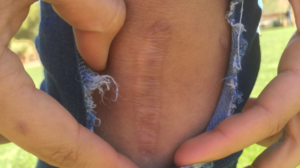
One of the most common knee injury in sports — the ACL tear — is on the rise, especially among women, but is no longer the end of an athlete’s career.
A study published in 2017 by a physician at the University of Minnesota, Nicholas Beck, showed ACL tears have increased over 2 percent in 6-18-year olds in the United States over the last two decades.
It is often seen on television during a basketball or football game but that is not where most of these injuries are happening. Chicago surgeon, Dr. Ronak Patel of the American Knee Institute said, “Typically female’s soccer players have the highest percentage of ACL tears.”
The most common sports ACL tears occur in soccer because the sport requires the player to make frequent pivots, cuts and jump. Several studies show females are eight times more likely to suffer an ACL tear than a male. Researchers are yet to figure out the reason for this, but believe it has to do with anatomical differences.
Patel explained, “Woman have wider hips and pelvis compared to men. The wider pelvis and hip coming into your knee means more of a chance to form a ‘knock-knee angle’. The ‘knock-knee angle’ is a high risk angle for an ACL tear.”

Jim Krumpos, the University of Arizona athletics assistant athletics director for performance enhancement, gave a similar explanation to Patel, saying the wider hips create an awkward angle for the knee. “When females land their knee is often locked or not over their toes,” he added.
Krumpos started working for the University of Arizona Athletics program in 1999 before leaving to the University of Miami for two years. He rejoined the Arizona Wildcat in 2013. He worked with Arizona divers in the 2016 Olympic Games in Brazil.
Krumpos works with athletes in all sports specializing in soccer, basketball, baseball, volleyball and diving. “Woman’s soccer is the worst I’ve seen for knees. A combination of all the cutting and all that. Plus, they are wearing cleats, a lot of the time the foot is stuck in the ground. There is no way for the foot to move as they are running and the hip is loaded, so what gives out is the knee.”
Krumpos rehabbed former Arizona Wildcat soccer player Karina Gabino two times. Gabino said, “I tore it twice in the years I was playing at U of A. I tore it once my freshman year, in the spring. Four weeks after I got cleared I tore my other ACL.”
Athletes that tear their ACL once are more likely to suffer more ACL tears. Krumpos explained, “This happens because athletes overcompensate and put too much stress on the healthy knee. When the knee can’t handle all the stress it locks and that’s when you have issues,” Krumpos said.
Gabino wasn’t the only athlete to tear her ACL during her time in Tucson. Gabino said, “From when I started to when I quit my junior year, my program went through a lot of ACL’s. My freshman year we had three girls, then my sophomore year I want to say we had four and my junior year coming in we already had one girl tear her ACL.”
The rehab process ranges anywhere from nine months to a year until an athlete is cleared, depending on when a doctor feels comfortable enough to allow the player back on the playing field. Both males and females usually finish rehab in this time frame.
“Most people feel pretty good by 4-6 months. It is not often the healing process; it is the readiness to return to play. Having the mental confidence in your knee is a big factor in when athletes come back.” Patel said,
After rehabbing her ACL, a second time, and getting back to the soccer field, Gabino’s soccer career was cut short. Her knee would pop when she made cuts and she did not have the confidence in her knee, which forced her to give up soccer.
Gabino believes that tearing your ACL comes with the risk of playing soccer. “It’s a really bad injury that can end careers, but at the same time it comes with the territory of playing a sport. In soccer we cut and pivot constantly, in baseball they throw constantly and many have rotator cuff issues,” she said.
Surgery has improved with medical advancements over the last decade. Patel said, “Surgery has come a long way from 10 years ago. We have realized that paying attention and putting the ACL exactly where it needs to be has led to better surgical outcomes. We are getting better from a surgical standpoint at locating where to put the ACL.
Although surgical procedures are much improved experts believe there’s still room to grow.
“I don’t know how much more we can improve from a surgical standpoint, since its pretty good. We have made strides, but there’s always room to improve and get it better.” Patel said.
Conor Redmond, a service from the School of Journalism with the University of Arizona. Contact him at cjredmond94@email.arizona.edu
Click here for high-resolution photographs and a Word version of the story.

